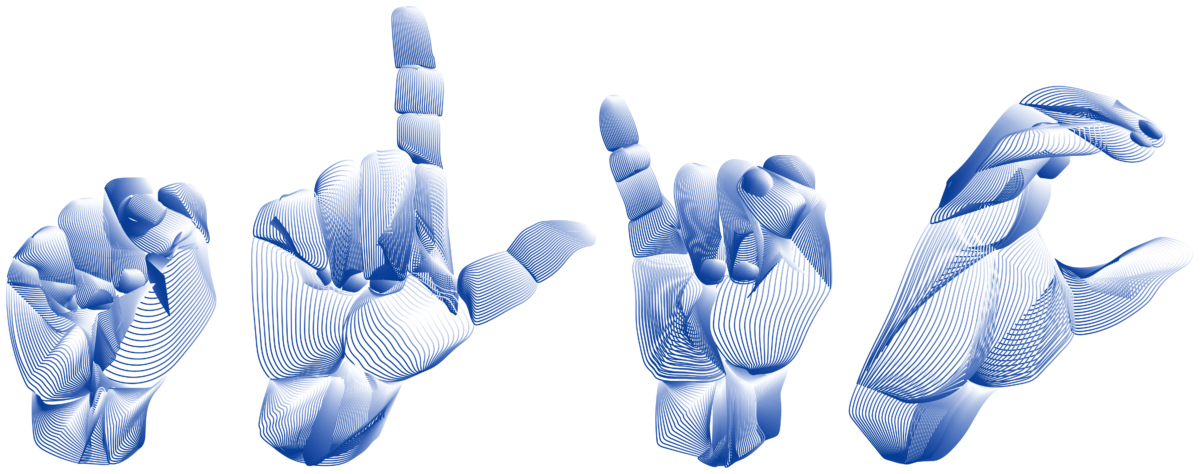Open (ATC20)
This course requires students to develop their ASL dance skills and learn the theoretical basis for working with a partner and/or group in executing fluid ASL/dance movements. Student learning will include the processes that form the basis for creating dance (cues, communication with others); the historical development of dance; appropriate ASL interpretation of the song lyrics /beats; students’ own aesthetic appreciation of dance as they participate in dance class, rehearsals, and performances; and the specialized vocabulary of dance criticism.
Note: In dance, the medium of expression is movement, the instrument is the human body and the guide is the musical rhythms. A large percent of Deaf individuals rely on visual cues & contact with other performers, counting to the beats and vibration created by the music as their guide to dancing. This presents an opportunity for students to increase their dancing skills of the three essential dance forms and observe the relationship between ASL, dance forms and musical rhythms.
Reference: For a list of links, please click on “Dance Resources”.
Overall Expectations
By the end of this course, students will:
• understand the relationship between ASL and dance movements;
• identify and explain the historical and cultural significance of two or more ASL dance forms (basic alternative swing, modern/freestyle contemporary and locking hip-hop);
• observe, identify, and describe a broad spectrum of ASL dance;
• understand how basic techniques (cues, communication with others, counting) assist in the development of self-discipline and contribute to artistic and fluidity scopes;
• apply the elements of ASL dance and various stimuli to create movement sequences;
• use improvisation to vary established movement patterns;
• devise different approaches to compositional forms;
• define, describe and use the criteria for analysing ASL dance within basic alternative swing, modern/freestyle contemporary and locking hip-hop dance spectrum;
• compare and contrast a broad spectrum of basic alternative swing, modern/freestyle contemporary and locking hip-hop ASL dance;
• investigate and report on various ASL dance performances, companies and organizations.
Specific Expectations
By the end of this course, students will:
• observe and describe a broad spectrum of basic alternative swing, modern/freestyle contemporary and locking hip-hop dance (e.g., swing – “Rock Around the Clock”, contemporary – “You Show Me”, hip-hop – any 70’s songs or James Brown);
• compare and contrast the historical development and cultural significance of various ASL dance forms from around the world;
• describe ways in which dance is part of culture within the Deaf community, in their culture or local community, province, in Canada, and worldwide (eg. Dancing Hands, China Disabled [Deaf] Performing Arts Troupe, Chan Danse des Sourds, Invisible Hands, ASL Waves);
• identify more complex movement terminology pertaining to basic alternative swing, modern/freestyle contemporary and locking hip-hop dance form(s) studied (e.g., basic alternative swing- (ballroom) triple step, coaster step, (latin) cross body lead, crossover break, parallel breaks, toe to head and modern/freestyle contemporary – (ballet) arabesques, port de bras, plie, fouette and locking hip-hop – applejax, the skeeter rabbit, box split, hop kick, leo walk, lock, stomp, the cockroach, scooby doo, wrist roll or twirl, bop-top, knee drop);
• demonstrate more complex ASL/movement fused skills, patterns, combinations, body positions, locomotors and non-locomotors movements in two or more dance forms studied;
• demonstrate an understanding of how basic technique functions (cues, eye contact, counting, leading, communicating with others) as a tool in developing coordinated partner and/or group artistic scope;
• explain the role of coordination between ASL and body movement in dance;
• apply the elements of ASL (e.g., poetic use of ASL, ASL rhymes, stylistic/dramatic use of ASL) and dance (e.g., flow, energy, space, time) to create movement sequences;
• observe and demonstrate improvised ASL and dance movement patterns (absolute and/or adjusted patterns), combinations, studies, and group dances
• demonstrate ability and create increasingly long and complex ASL dance compositions, exploring themes, ideas, and topics as well polish pieces, fluidity, refine techniques and ASL/dance movement memory;
• define the criteria for analysing ASL dance and analyse improvisations, movement phrases, and more formal compositions created in class;
• reflect and report – in ASL and written form – on their own compositions and those of others (their peers, Deaf dancers in other performances);
• use videotapes, DVDs, the Internet, and/or other multimedia technologies to compare and contrast topics and themes in ASL dance (e.g., Rathskeller, Flux Fusion, Wild Zappers and Dancing Hands);


